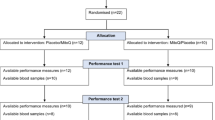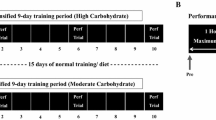Abstract
Purpose
To evaluate the effect of antioxidant supplementation on intense endurance exercise performance and the physiologic exercise response acutely and in early recovery.
Methods
Well-trained cyclists (n = 11, peak VO2: 69 ± 7 ml/min/kg) completed two identical standardized 20-min warm-up periods (WU-1 and WU-2) prior to two performance tests (PT) with a duration of ~ 4 min representing a qualifying (PT-1) and final race (PT-2) on the same day separated by 90 min. Subjects were supplemented orally with placebo (PLA) and N-acetyl cysteine (NAC; 20 mg/kg) before exercise in a double-blinded crossover design.
Results
Mean power during PT-1 did not differ (P = 0.39) between PLA (400 ± 44 W) and NAC (401 ± 44 W) as was the case during PT-2 with similar performance (P = 0.74) between PLA (401 ± 43 W) and NAC (400 ± 42 W). Subjective “readiness” was lowered by prior exhaustive exercise from PT-1 to PT-2 (P = 0.012) in both PLA and NAC. Plasma total antioxidant capacity was not affected by supplementation and prior exhaustive exercise (respective main effects: P = 0.83 and P = 0.19) which also was observed for peak VO2 at ~ 5 L/min (P = 0.84 and P = 0.30). In WU-1 and WU-2, both cycling economy at ~ 20% (P = 0.10 and P = 0.21) and plasma potassium at ~ 5 mmol/L (P = 0.46 and P = 0.26) were unaffected by supplementation and prior exercise.
Conclusions
Athletes executing maximal efforts of a ~ 4-min duration twice daily, as seen in track cycling, appear to gain no benefit from oral NAC supplementation on acute and subsequent performance following short-term recovery. Moreover, well-trained cyclists exhibit rapid recovery from a single bout of intense endurance cycling.






Similar content being viewed by others
Abbreviations
- °C:
-
Degrees celsius
- GE:
-
Gross efficiency
- iPPO:
-
Incremental-test peak power output
- kg:
-
Kilogram
- kJ:
-
Kilojoule
- L:
-
Liters
- m:
-
Meters
- mg:
-
Milligram
- min:
-
Minute
- mmol:
-
Millimole
- NAC:
-
N-Acetyl cysteine
- PLA:
-
Placebo
- P:O:
-
Phosphate/oxygen ratio
- PT:
-
Performance test
- ROS:
-
Reactive oxygen species
- s:
-
Second
- TAC:
-
Total antioxidant capacity
- VO2 :
-
Pulmonary oxygen uptake
- WU:
-
Warm-up
- W:
-
Watt
References
Bailey SJ, Winyard PG, Blackwell JR, Vanhatalo A, Lansley KE, Dimenna FJ, Wilkerson DP, Campbell IT, Jones AM (2011) Influence of N-acetylcysteine administration on pulmonary O2 uptake kinetics and exercise tolerance in humans. Respir Physiol Neurobiol 175(1):121–129. https://doi.org/10.1016/j.resp.2010.10.002 (Epub 2010 Oct 16)
Borgström L, Kågedal B, Paulsen O (1986) Pharmacokinetics of N-acetylcysteine in man. Eur J Clin Pharmacol 31(2):217–222
Christensen PM, Bangsbo J (2015) Warm-up strategy and high-intensity endurance performance in trained cyclists. Int J Sports Physiol Perform 10(3):353–360. https://doi.org/10.1123/ijspp.2014-0228 (Epub 2014 Sep 17)
Christensen PM, Bangsbo J (2016) Influence of Prior Intense Exercise and Cold Water Immersion in Recovery for Performance and Physiological Response during Subsequent Exercise. Front Physiol. 7:269. https://doi.org/10.3389/fphys.2016.00269 (eCollection 2016)
Christensen PM, Shirai Y, Ritz C, Nordsborg NB (2017) Caffeine and bicarbonate for speed. A meta-analysis of legal supplements potential for improving intense endurance exercise performance. Front Physiol 8:240. https://doi.org/10.3389/fphys.2017.00240 (eCollection 2017)
Cobley JN, McGlory C, Morton JP, Close GL (2011) N-Acetylcysteine’s attenuation of fatigue after repeated bouts of intermittent exercise: practical implications for tournament situations. Int J Sport Nutr Exerc Metab 21(6):451–461
Corn SD, Barstow TJ (2011) Effects of oral N-acetylcysteine on fatigue, critical power, and W’ in exercising humans. Respir Physiol Neurobiol 178(2):261–268. https://doi.org/10.1016/j.resp.2011.06.020 (Epub 2011 Jun 29)
Craig NP, Norton KI (2001) Characteristics of track cycling. Sports Med 31(7):457–468 (Review)
Doherty M, Smith P, Hughes M, Davison R (2004) Caffeine lowers perceptual response and increases power output during high-intensity cycling. J Sports Sci 22(7):637–643
Gejl KD, Hvid LG, Willis SJ, Andersson E, Holmberg HC, Jensen R, Frandsen U, Hansen J, Plomgaard P, Ørtenblad N (2016) Repeated high-intensity exercise modulates Ca(2+) sensitivity of human skeletal muscle fibers. Scand J Med Sci Sports 26(5):488–497. https://doi.org/10.1111/sms.12483 (Epub 2015 May 5)
Gliemann L, Nyberg M, Hellsten Y (2014) Nitric oxide and reactive oxygen species in limb vascular function: what is the effect of physical activity? Free Radic Res 48(1):71–83. https://doi.org/10.3109/10715762.2013.835045 (Epub 2013 Oct 7)
Hostrup M, Bangsbo J (2017) Limitations in intense exercise performance of athletes—effect of speed endurance training on ion handling and fatigue development. J Physiol 595(9):2897–2913. https://doi.org/10.1113/jp273218 (Epub 2016 Nov 16. Review)
McKenna MJ, Medved I, Goodman CA, Brown MJ, Bjorksten AR, Murphy KT, Petersen AC, Sostaric S, Gong X (2006) N-Acetylcysteine attenuates the decline in muscle Na+, K+-pump activity and delays fatigue during prolonged exercise in humans. J Physiol 576(Pt 1):279–288 (Epub 2006 Jul 13)
Medved I, Brown MJ, Bjorksten AR, Leppik JA, Sostaric S, McKenna MJ (2003) N-Acetylcysteine infusion alters blood redox status but not time to fatigue during intense exercise in humans. J Appl Physiol 94(4):1572–1582 (Epub 2002 Dec 20)
Medved I, Brown MJ, Bjorksten AR, McKenna MJ (2004a) Effects of intravenous N-acetylcysteine infusion on time to fatigue and potassium regulation during prolonged cycling exercise. J Appl Physiol 96(1):211–217 (Epub 2003 Sep 5)
Medved I, Brown MJ, Bjorksten AR, Murphy KT, Petersen AC, Sostaric S, Gong X, McKenna MJ (2004b) N-Acetylcysteine enhances muscle cysteine and glutathione availability and attenuates fatigue during prolonged exercise in endurance-trained individuals. J Appl Physiol 97(4):1477–1485 (Epub 2004 Jun 11)
Michailidis Y, Karagounis LG, Terzis G, Jamurtas AZ, Spengos K, Tsoukas D, Chatzinikolaou A, Mandalidis D, Stefanetti RJ, Papassotiriou I, Athanasopoulos S, Hawley JA, Russell AP, Fatouros IG (2013) Thiol-based antioxidant supplementation alters human skeletal muscle signaling and attenuates its inflammatory response and recovery after intense eccentric exercise. Am J Clin Nutr. 98(1):233–245. https://doi.org/10.3945/ajcn.112.049163 (Epub 2013 May 29)
Mohr M, Nielsen TS, Weihe P, Thomsen JA, Aquino G, Krustrup P, Nordsborg NB (2017) Muscle ion transporters and antioxidative proteins have different adaptive potential in arm than in leg skeletal muscle with exercise training. Physiol Rep 5(19):e13470. https://doi.org/10.14814/phy2.13470 (Epub 2017 Oct 16)
Nielsen HB, Secher NH, Christensen NJ, Pedersen BK (1996) Lymphocytes and NK cell activity during repeated bouts of maximal exercise. Am J Physiol 271(1 Pt 2):R222–R227
Nielsen HB, Kharazmi A, Bolbjerg ML, Poulsen HE, Pedersen BK, Secher NH (2001) N-Acetylcysteine attenuates oxidative burst by neutrophils in response to ergometer rowing with no effect on pulmonary gas exchange. Int J Sports Med 22(4):256–260
Paschalis V, Theodorou AA, Margaritelis NV, Kyparos A, Nikolaidis MG (2018) N-Acetylcysteine supplementation increases exercise performance and reduces oxidative stress only in individuals with low levels of glutathione. Free Radic Biol Med. 115:288–297. https://doi.org/10.1016/j.freeradbiomed.2017.12.007 (Epub 2017 Dec 9)
Pendyala L, Creaven PJ (1995) Pharmacokinetic and pharmacodynamic studies of N-acetylcysteine, a potential chemopreventive agent during a phase I trial. Cancer Epidemiol Biomark Prev 4(3):245–251
Powers SK, Jackson MJ (2008) Exercise-induced oxidative stress: cellular mechanisms and impact on muscle force production. Physiol Rev 88(4):1243–1276. https://doi.org/10.1152/physrev.00031.2007
Rafiq S, Huma N, Pasha I, Sameen A, Mukhtar O, Khan MI (2016) Chemical composition, nitrogen fractions and amino acids profile of milk from different animal species. Asian Aust J Anim Sci. 29(7):1022–1028. https://doi.org/10.5713/ajas.15.0452 (Epub 2015 Dec 5)
Reid MB (2016) Redox interventions to increase exercise performance. J Physiol. 594(18):5125–5133. https://doi.org/10.1113/jp270653 (Epub 2015 Dec 20)
Rhodes K, Braakhuis A (2017) Performance and side effects of supplementation with N-acetylcysteine: a systematic review and meta-analysis. Sports Med. 47(8):1619–1636. https://doi.org/10.1007/s40279-017-0677-3
Slattery KM, Dascombe B, Wallace LK, Bentley DJ, Coutts AJ (2014) Effect of N-acetylcysteine on cycling performance after intensified training. Med Sci Sports Exerc 46(6):1114–1123. https://doi.org/10.1249/mss.0000000000000222
Spencer MR, Gastin PB (2001) Energy system contribution during 200- to 1500-m running in highly trained athletes. Med Sci Sports Exerc 33(1):157–162
Tonkonogi M, Walsh B, Tiivel T, Saks V, Sahlin K (1999) Mitochondrial function in human skeletal muscle is not impaired by high intensity exercise. Pflugers Arch 437(4):562–568
Tonkonogi M, Walsh B, Svensson M, Sahlin K (2000) Mitochondrial function and antioxidative defence in human muscle: effects of endurance training and oxidative stress. J Physiol 528(pt 2):379–388
Trewin AJ, Petersen AC, Billaut F, McQuade LR, McInerney BV, Stepto NK (2013) N-Acetylcysteine alters substrate metabolism during high-intensity cycle exercise in well-trained humans. Appl Physiol Nutr Metab 38(12):1217–1227. https://doi.org/10.1139/apnm-2012-0482 (Epub 2013 Jun 6)
Wiles JD, Bird SR, Hopkins J, Riley M (1992) Effect of caffeinated coffee on running speed, respiratory factors, blood lactate and perceived exertion during 1500-m treadmill running. Br J Sports Med 26:116–120. https://doi.org/10.1136/bjsm.26.2.116
Zembron-Lacny A, Slowinska-Lisowska M, Szygula Z, Witkowski Z, Szyszka K (2010) Modulatory effect of N-acetylcysteine on pro-antioxidant status and haematological response in healthy men. J Physiol Biochem 66(1):15–21. https://doi.org/10.1007/s13105-010-0002-1 (Epub 2010 Mar 31)
Acknowledgements
The authors wish to thank Caecilie Christoffersen for her great contribution to the experiment and also Kasper Eiby, Lasse Gliemann and Thomas Gunnarsson for placement of venous catheters and Jens Jung Nielsen for plasma analysis. The study was supported by Team Danmark.
Author information
Authors and Affiliations
Corresponding author
Ethics declarations
Conflict of interest
The authors declare that they have no conflict of interest.
Ethical approval
All procedures performed in studies involving human participants were in accordance with the ethical standards of the institutional and/or national research committee and with the 1964 Helsinki Declaration and its later amendments or comparable ethical standards.
Additional information
Communicated by Anni Vanhatalo.
Publisher's Note
Springer Nature remains neutral with regard to jurisdictional claims in published maps and institutional affiliations.
Rights and permissions
About this article
Cite this article
Christensen, P.M., Bangsbo, J. N-Acetyl cysteine does not improve repeated intense endurance cycling performance of well-trained cyclists. Eur J Appl Physiol 119, 1419–1429 (2019). https://doi.org/10.1007/s00421-019-04132-7
Received:
Accepted:
Published:
Issue Date:
DOI: https://doi.org/10.1007/s00421-019-04132-7




